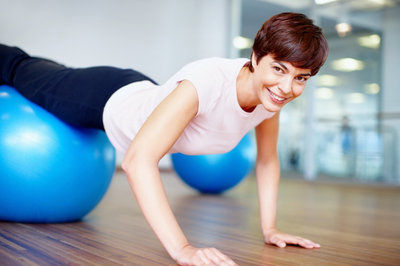The push-up is a fundamental exercise that I routinely use with most of my clients. It works the whole body and can be easily modified for either the 75-year-old woman or the 25-year-old athlete.
Push-ups engage numerous muscles, including the core (a group of muscles that support and protect the back), the chest, the shoulders and the triceps (the area on the back of the arm that can get loose and wobbly, causing the “double goodbye” effect when waving).
As with any exercise, proper form is the most important factor. The spine should remain neutral, not swayed, so that the body forms a straight line from head to hips to heels. Place your hands directly in line with and slightly wider than your shoulders, and lower your body by bending the elbows and leading with the chest, as opposed to sinking the hips or leading with the head.
Each person’s ideal range of motion — how low one should go — will depend on strength, mobility and past injuries to the shoulder or elbow. It’s best to work within a range that is both challenging and safe. If you experience strain or discomfort in the lower back, chances are your core muscles are not strong enough to support you, in which case you should regress your push-up to an easier version and build core strength by holding the plank position. The moment your form begins to get sloppy, stop immediately.
Push-ups should be part of a balanced training program that incorporates some back-strengthening exercises. Respect the limitations of your own body and those established by your doctor.
Kitchen counter push-up (beginner)
Place your hands on the edge of the kitchen counter, align your mid (not upper) chest with the edge of the countertop, and proceed with standard push-up form, as described above. Only go as low as you feel comfortable.
Once you can do 20 good repetitions at the kitchen counter, move to the back of the couch. With dedication and consistency, you will eventually graduate to the side of the bathtub. Always use a stable surface that will not budge under the weight of your body.
Ball push-up (beginner, intermediate, advanced)
Incorporating a 55- to 65-centimeter inflatable exercise ball challenges the core muscles by introducing an unstable surface under the legs or feet. With your hands on the floor in standard push-up position, use the following guidelines to determine where to position the ball.
Beginners should start with their hips or thighs on the ball. As you get stronger, move the ball closer to your shins. More advanced individuals should try placing their feet on the top of the ball. Still too easy? Try lifting one leg about 4 inches in the air.
Push-up with dumbbell row (advanced)
Start in standard push-up form, holding a dumbbell in each hand and legs slightly apart. Go down as you would with a standard push-up. Do not go lower than the depth of your hands. Push up and pull one dumbbell off the floor in a rowing motion, lifting the weight toward the armpit and retracting the shoulder blade toward the spine. Be attentive to keeping your hips level, resisting the temptation to twist them. Place the weight back on the floor and repeat on the other side.
Dumbbells can range from 5 pounds to 35 pounds or more. Use dumbbells with a flat surfaces, as they are less likely to roll.
Julia Blanton is a nutrition, fitness and wellness coach. An avid runner, she works at Club One in Scotts Valley and keeps a health blog at www.juliablanton.com.












